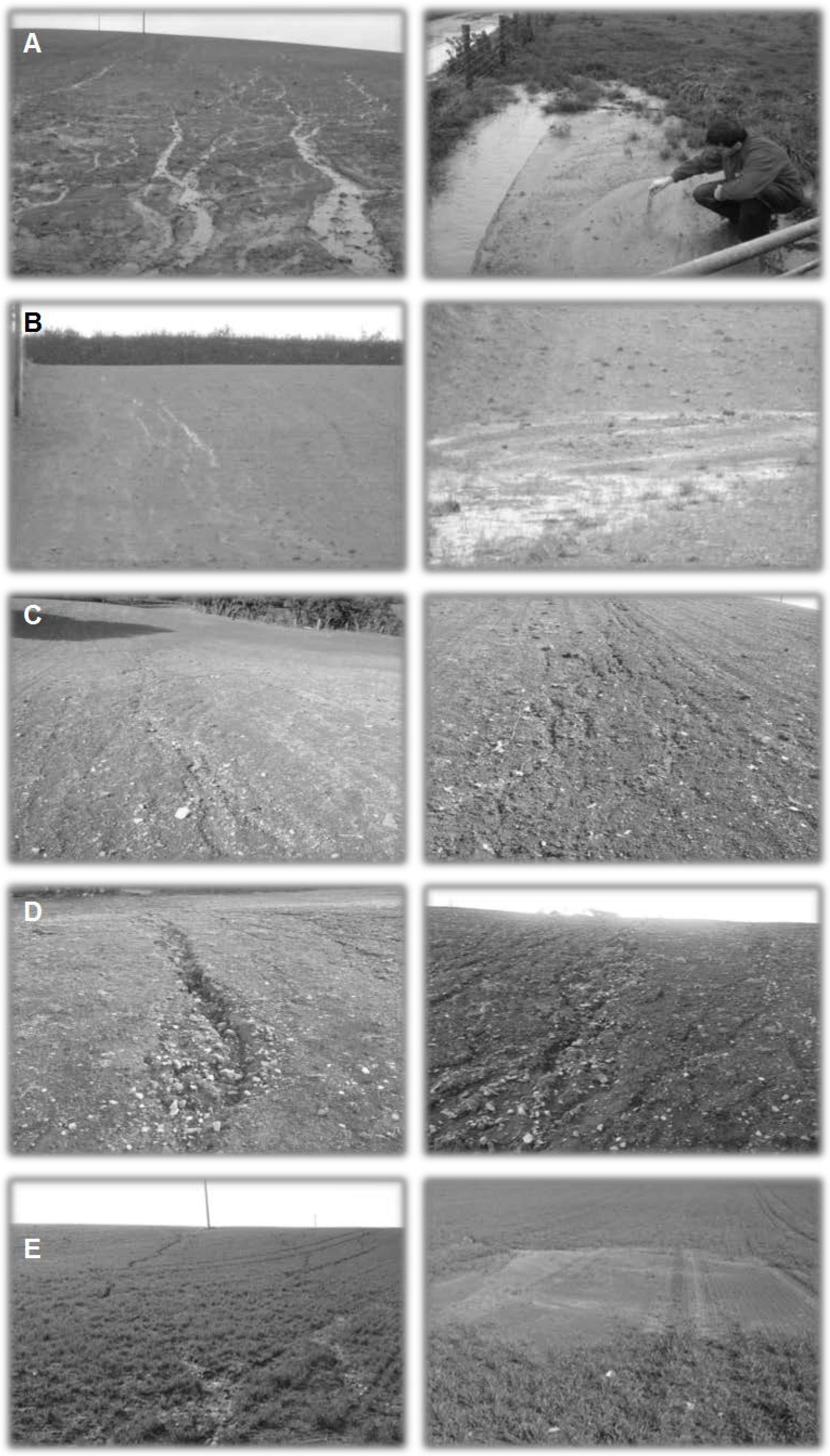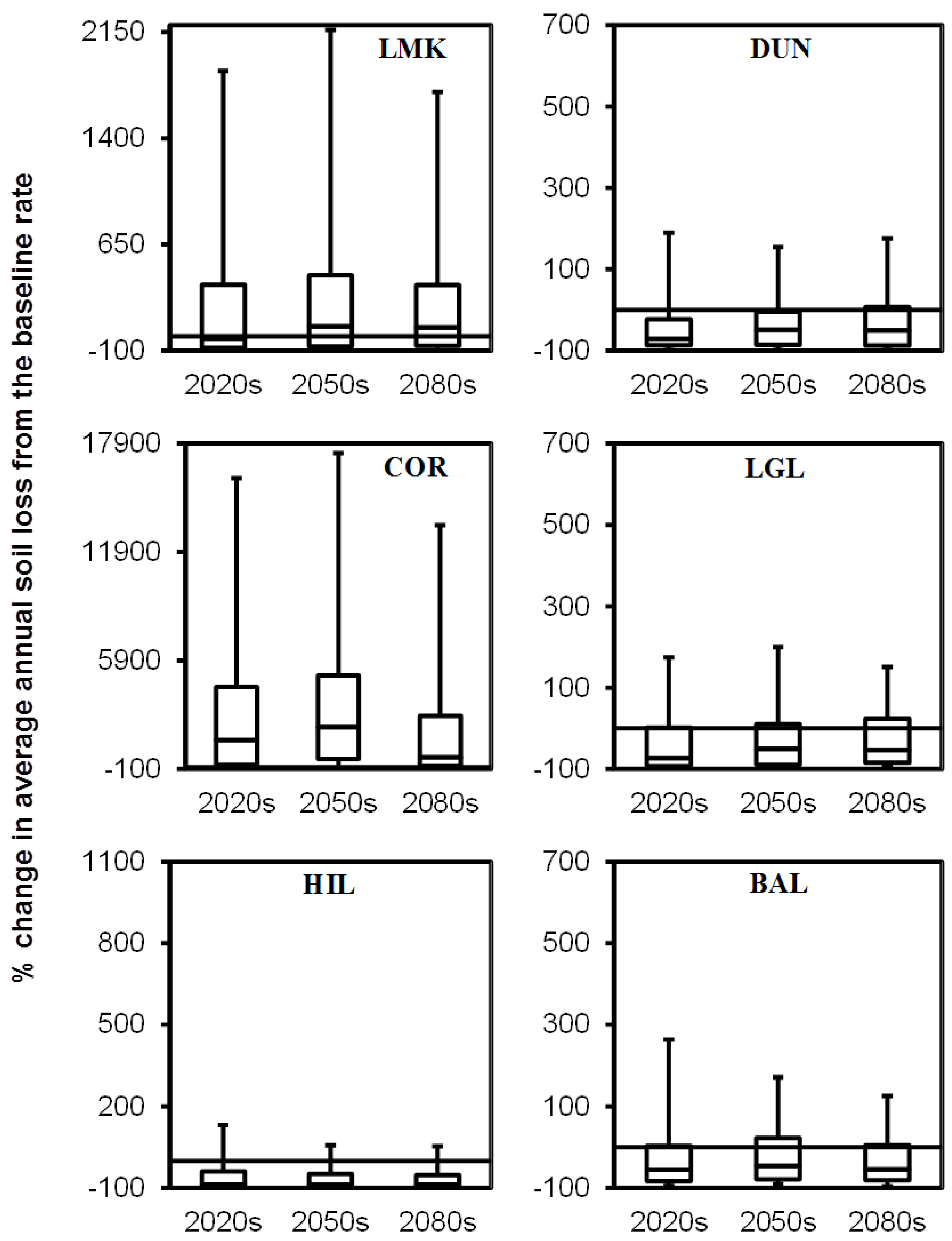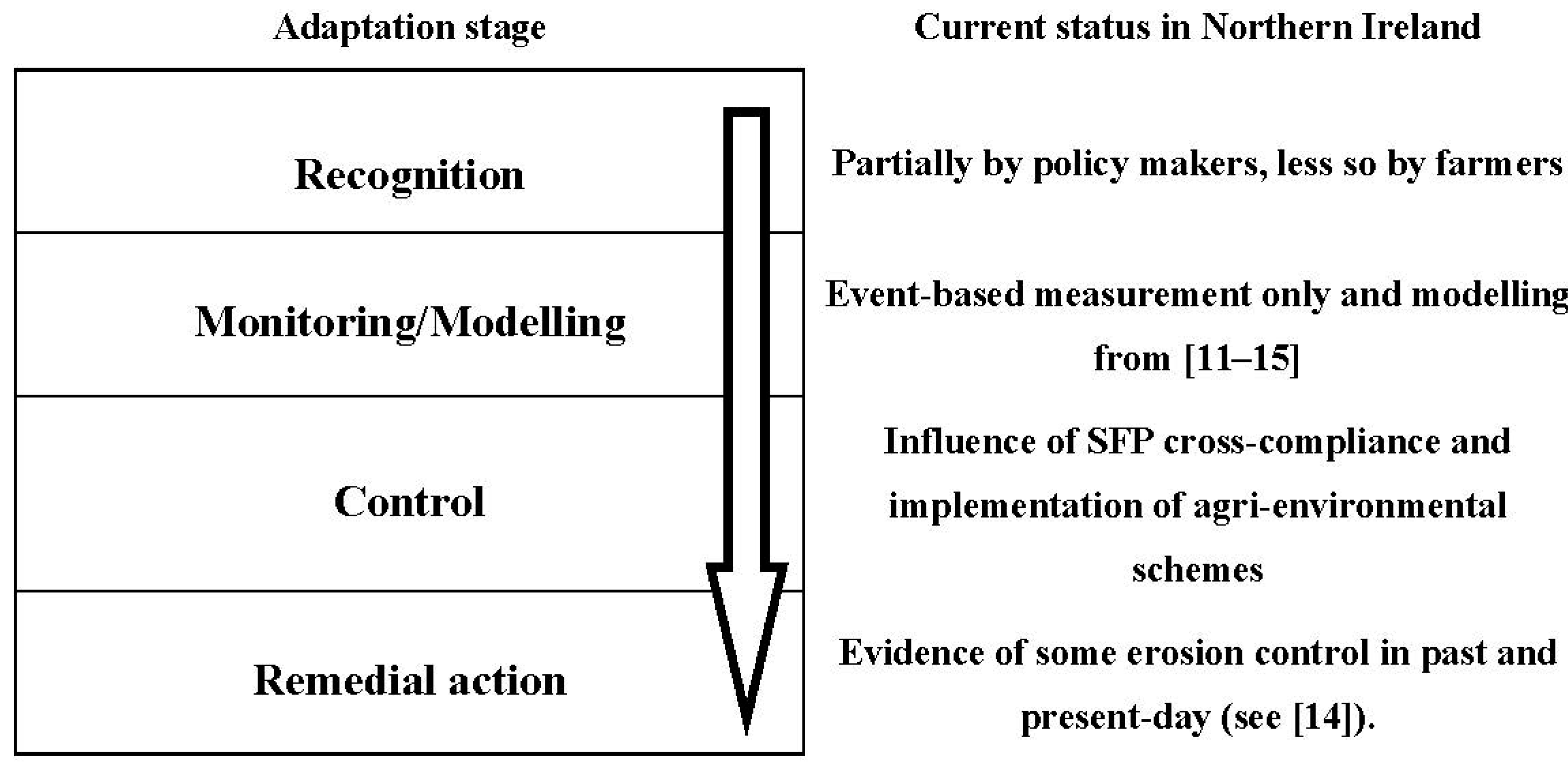Managing Soil Erosion in Northern Ireland: A Review of Past and Present Approaches
Abstract
:1. Introduction
2. Approaches and Barriers to Managing Soil Erosion in Northern Ireland
2.1. Past and Present-Day Policies
2.1.1. Agricultural Policies Post-World War 2
2.1.2. Towards Agri-Environmental Policies
| Year | Policy | Objective |
|---|---|---|
| 2003 | Water Framework Directive | To achieve good ecological and chemical status in surface waters |
| 2005 | Single Farm Payment | To keep land in good agricultural and environmental condition |
| 2007–2013 | Countryside Management Scheme/Environmentally Sensitive Areas | To improve the environment and the countryside through land management |
| 2005 | Farm Nutrient Management Scheme | To reduce nutrient runoff to surface waters |
2.2. Are Present-Day Policies Helping to Reduce Erosion?
2.2.1. Policy Effectiveness in Reducing Erosion
2.2.2. Issues of Farmer Compliance

3. Future Policy Considerations for Northern Ireland

3.1. Clearer Definitions for Environmental Standards
3.2. Greater Enforcement of Subsidy Requirements
3.3. Raising Awareness through Education
3.4. Implementation of Conservation Strategies
3.5. Specific Agri-Environmental Measures
3.6. Research Required to Facilitate Suggested Approaches

4. Conclusions
Acknowledgments
Conflicts of interest
References
- Soil Quality and Soil Erosion; Lal, R. (Ed.) Soil and Water Conservation Society: Ankeny, IA, USA, 1999.
- Morgan, R.P.C. Soil Erosion and Conservation, 3rd ed.; Blackwell Publishing Limited: Oxford, UK, 2005. [Google Scholar]
- He, X.; Zhou, J.; Zhang, X.; Tang, K. Soil erosion response to climatic change and human activity during the Quaternary on the Loess Plateau, China. Reg. Environ. Chang. 2006, 6, 62–70. [Google Scholar] [CrossRef]
- Lal, R.; Stewart, B.A. Soil Degradation; Springer-Verlag: New York, NY, USA, 1990. [Google Scholar]
- Pimentel, D. Soil erosion: A food and environmental threat. Environ. Dev. Sustain. 2006, 8, 119–137. [Google Scholar] [CrossRef]
- Langdale, G.W.; West, L.T.; Bruce, R.R.; Miller, W.P.; Thomas, A.W. Restoration of eroded soil with conservation tillage. Soil Technol. 1992, 5, 81–90. [Google Scholar] [CrossRef]
- Pimentel, D.; Harvey, C.; Resosudarmo, P.; Sinclair, K.; Kurz, D.; MnCair, M.; Crist, S.; Shpritz, L.; Fitton, L.; Saffouri, R.; et al. Environmental and economic costs of soil erosion and conservation benefits. Science 1995, 267, 1117–1123. [Google Scholar] [CrossRef]
- Wardle, D.A.; Bardgett, R.D.; Klironomos, J.N.; Setälä, H.; van der Putten, W.H.; Wall, D.H. Ecological linkages between aboveground and belowground biota. Science 2004, 304, 1634–1637. [Google Scholar] [CrossRef]
- Boardman, J. A short history of muddy floods. Land Degrad. Dev. 2010, 21, 303–309. [Google Scholar] [CrossRef]
- Boardman, J.; Shepheard, M.L.; Walker, E.; Foster, I.D.L. Soil erosion and risk-assessment for on- and off-farm impacts: A test case using the Midhurst area, West Sussex, UK. J. Environ. Manag. 2009. [Google Scholar] [CrossRef]
- Mullan, D.J.; Favis-Mortlock, D.T.; Fealy, R. Addressing key limitations associated with modelling soil erosion under the impacts of future climate change. Agric. For. Meteorol. 2012, 156, 18–30. [Google Scholar] [CrossRef]
- Mullan, D.J.; Favis-Mortlock, D.T. Managing soil erosion: A case study from Ireland. Geogr. Rev. 2011, 24, 24–26. [Google Scholar]
- Favis-Mortlock, D.T.; Mullan, D.J. Soil Erosion by Water under Future Climate Change. In Soil Hydrology, Land Use and Agriculture: Measurement and Modelling; Shukla, M., Ed.; CABI Publishing: Wallingford, UK, 2011; pp. 384–414. [Google Scholar]
- Mullan, D.J. Soil erosion on agricultural land in the north of Ireland: Past, present and future potential. Ir. Geogr. 2013. [Google Scholar] [CrossRef]
- Mullan, D.J. Soil erosion under the impacts of future climate change: Assessing the statistical significance of future changes and the potential on-site and off-site problems. Catena 2013, 109, 234–246. [Google Scholar] [CrossRef]
- Favis-Mortlock, D.T.; Savabi, M.R. Shifts in Rates and Spatial Distributions of Soil Erosion and Deposition under Climate Change. In Advances in Hillslope Processes; Anderson, M.G., Brooks, S.M., Eds.; Wiley: Chichester, UK, 1996; Volume 1. [Google Scholar]
- Williams, J.; Nearing, M.A.; Nicks, A.; Skidmore, E.; Valentine, C.; King, K.; Savabi, R. Using soil erosion models for global change studies. J. Soil Water Conserv. 1996, 51, 381–385. [Google Scholar]
- Favis-Mortlock, D.T.; Guerra, A.J.T. The implications of general circulation model estimates of rainfall for future erosion: A case study from Brazil. Catena 1999, 37, 329–354. [Google Scholar] [CrossRef]
- Nearing, M.A. Potential changes in rainfall erosivity in the U.S. with climate change during the 21st century. J. Soil Water Conserv. 2001, 56, 229–232. [Google Scholar]
- Pruski, F.F.; Nearing, M.A. Climate-induced changes in erosion during the 21st century for eight U.S. locations. Water Resour. Res. 2002, 38, Article 1298. [Google Scholar]
- Trenberth, K.E.; Dai, A.; Rasmussen, R.M.; Parsons, D.B. The changing character of precipitation. Bull. Am. Meteorol. Soc. 2003, 84, 1205–1217. [Google Scholar] [CrossRef]
- Nearing, M.A.; Jetten, V.; Baffaut, C.; Cerdan, O.; Couturier, A.; Hernandez, M.; Le Bissonnais, Y.; Nichols, M.H.; Nunes, J.P.; Renschler, C.S.; et al. Modeling response of soil erosion and runoff to changes in precipitation and cover. Catena 2005, 61, 131–154. [Google Scholar] [CrossRef]
- Rosenzweig, C.; Hillel, D. Climate Change and the Global Harvest. Potential Impacts of the Greenhouse Effect on Agriculture; Oxford University Press Inc.: New York, NY, USA, 1998. [Google Scholar]
- Verspecht, A.; Vandermeulen, V.; de Bolle, S.; Moeskops, B.; Vermang, J.; van den Bossche, A.; van Huylenbroeck, G.; de Neve, S. Integrated policy approach to mitigate soil erosion in West Flanders. Land Degrad. Dev. 2011, 22, 84–96. [Google Scholar] [CrossRef]
- Prazan, J.; Dumbrovsky, M. Soil conservation policies: Conditions for their effectiveness in the Czech Republic. Land Degrad. Dev. 2010, 21, 124–133. [Google Scholar]
- Schuler, J.; Sattler, C. The estimation of agricultural policy effects on soil erosion-An application for the bio-economic model MODAM, 2010. Land Use Policy 2010, 27, 61–69. [Google Scholar] [CrossRef]
- Lundekvam, H.E.; Romstad, E.; Øygarden, L. Agricultural policies in Norway and effects on soil erosion. Environ. Sci. Policy 2003, 6, 57–67. [Google Scholar] [CrossRef]
- Boellstorff, D.; Benito, G. Impacts of set-aside policy on the risk of soil erosion in central Spain. Agric. Ecosyst. Environ. 2005, 107, 231–243. [Google Scholar] [CrossRef]
- Evans, R. Runoff and soil erosion in arable Britain: Changes in perception and policy since 1945. Environ. Sci. Policy 2010, 13, 141–149. [Google Scholar] [CrossRef]
- DEFRA. Piloting a Cost-Effective Framework for Monitoring Soil Erosion in England and Wales; SP1311; Department for Environment Food and Rural Affairs: London, UK, 2013.
- European Commission. Thematic Strategy for Soil Protection (Communication); Brussels, 22-9-2006. COM (2006) 231 final; European Commission: Brussels, Belgium, 2006. [Google Scholar]
- Jones, A.; Panagos, P.; Barcelo, S.; Bouraoui, F.; Bosco, C.; Dewitte, O.; Gardi, C.; Erhard, M.; Hervás, J.; Hiederer, R.; et al. The State of Soil in Europe; European Commission Joint Research Centre: Ispra, Italy, 2012. [Google Scholar]
- European Commission. Common Agricultural Policy. A Partnership between Europe and Farmers; Publications Office of the European Union: Luxembourg, Luxembourg, 2012; p. 16. [Google Scholar]
- DEFRA. Soil Protection Review 2010 GAEC 1; Department for Environment Food and Rural Affairs: London, UK, 2010.
- European Commission. Establishing a Framework for Community Action in the Field of Water Policy; Directive 2000/60/EC of the European Parliament and of the Council; European Commission: Brussels, Belgium, 2000. [Google Scholar]
- Lilly, A.; Grieve, I.C.; Jordan, C.; Baggaley, N.J.; Birnie, R.V.; Futter, M.N.; Higgins, A.; Hough, R.; Jones, M.; Noland, A.J.; et al. Climate Change, Land Management and Erosion in the Organic and Organo-Mineral Soils in Scotland and Northern Ireland; Scottish Natural Heritage Commissioned Report No. 325 (ROAME No. F06AC104—SNIFFER UKCC21); Scottish Natural Heritage: Edinburgh, Scotland, UK, 2009. [Google Scholar]
- DEFRA. Common Agricultural Policy Reform, (On-Line), Department for the Environment, Food and Rural Affairs, London, 2011. Available online: http://www.defra.gov.uk/food-farm/farm-manage/cap-reform/ (accessed on 12 October 2011).
- Royal Commission on Environmental Pollution (RCEP). Sustainable Use of Soil; 19th Report; Her Majesty’s Stationery Office (HMSO): London, UK, 1996.
- Silvey, V. The contribution of new varieties to cereal yields in England and Wales between 1947 and 1983. J. Natl. Inst. Agric. Bot. 1986, 17, 155–168. [Google Scholar]
- Baird, W.W.; Tarrant, J.R. Hedgerow Destruction in Norfolk 1946–1970; School of Environmental Sciences, University of East Anglia: Norwich, UK, 1973. [Google Scholar]
- Environment Agency. The State of the Environment of England and Wales: The Land; Environment Agency, Her Majesty’s Stationery Office: London, UK, 2000.
- Evans, R.; Cook, S. Soil erosion in Britain. SEESOIL 1986, 3, 28–59. [Google Scholar]
- Favis-Mortlock, D.T. Ireland. In Soil Erosion in Europe; Boardman, J., Poesen, J., Eds.; Wiley: Chichester, UK, 2006. [Google Scholar]
- Robinson, D.A. Agricultural practice, climate change and the soil erosion hazard in parts of southeast England. Appl. Geogr. 1999, 19, 13–27. [Google Scholar] [CrossRef]
- Boardman, J. Soil erosion and flooding on the eastern South Downs, southern England, 1976–2001. Trans. Inst. Br. Geogr. 2003, 28, 176–196. [Google Scholar] [CrossRef]
- Boardman, J.; Evans, R.; Ford, J. Muddy floods on the South Downs, southern England: Problem and responses. Environ. Sci. Policy 2003, 6, 69–83. [Google Scholar] [CrossRef]
- Evans, R.; Boardman, J. Curtailment of muddy floods in the Sompting catchment, West Sussex, southern England. Soil Use Manag. 2003, 19, 223–231. [Google Scholar] [CrossRef]
- Evans, R. Curtailing water erosion of cultivated land: An example from north Norfolk, eastern England. Earth Surf. Processes Landf. 2006, 31, 598–605. [Google Scholar] [CrossRef]
- European Commission. On Support for Rural Development from the European Agricultural Guidance and Guarantee Fund; Council Regulation (EC) No. 1257/1999; European Commission: Brussels, Belgium, 1999. [Google Scholar]
- Department of Agriculture and Rural Development (DARD). Farm Nutrient Management Scheme (Northern Ireland) 2005 Scheme Booklet FNMS I; Department of Agriculture and Rural Development: Belfast, UK, 2005; p. 50.
- Fealy, R.; Sweeney, J. Statistical downscaling of temperature, radiation and potential evapotranspiration to produce a multiple GCM ensemble mean for a selection of sites in Ireland. Ir. Geogr. 2008, 41, 1–27. [Google Scholar] [CrossRef]
- Mullan, D.J.; Fealy, R.; Favis-Mortlock, D.T. Developing site-specific future temperature scenarios for Northern Ireland: Addressing key issues employing a statistical downscaling approach. Int. J. Climatol. 2012, 32, 2007–2019. [Google Scholar] [CrossRef]
- Lempert, R.; Nakicenovic, N.; Sarewitz, D.; Schlesinger, M. Characterizing climate change uncertainties for decision-makers - an editorial essay. Clim. Chang. 2004, 65, 1–9. [Google Scholar] [CrossRef]
- European Commission. On the Quality of Fresh Waters Needing Protection or Improvement in Order to Support Fish Life; Directive 2006/44/EC of the European Parliament and of the Council; European Commission: Brussels, Belgium, 2006. [Google Scholar]
- Collins, A.L.; Anthony, S.G. Assessing the likelihood of catchments across England and Wales meeting “good ecological status” due to sediment contributions from agricultural sources. Environ. Sci. Policy 2008, 11, 163–170. [Google Scholar] [CrossRef]
- Verheijen, F.G.A.; Jones, R.J.A.; Rickson, R.J.; Smith, C.J. Tolerable versus actual soil erosion rates in Europe. Earth Sci. Rev. 2009, 94, 23–38. [Google Scholar] [CrossRef] [Green Version]
- DARD. Guide to the Single Farm Payment (SFP) Scheme; Department of Agriculture and Rural Development: Belfast, UK, 2011; p. 39.
- MAFF. Soil Erosion by Water. ADAS Leaflet 890; Ministry of Agriculture, Fisheries and Food: Alnwick, UK, 1985.
- DEFRA. Controlling Soil Erosion: A Manual for the Assessment and Management of Agricultural Land at Risk of Water Erosion in Lowland England; Revised September 2005; Department for the Environment, Food and Rural Affairs: London, UK, 2005.
- Rural Payments Agency (RPA). Single Payment Scheme: Cross-Compliance Guidance for Soil Management 2010 Edition; Rural Payments Agency/Department for Environment Food and Rural Affairs: London, UK, 2010; p. 76. [Google Scholar]
- Evans, R. Outdoor pigs and flooding: an English case study. Soil Use Manag. 2004, 20, 178–181. [Google Scholar] [CrossRef]
- Verstraten, G.; Poesen, J.; Govers, G.; Gillijns, K.; van Rompaey, A.; van Oost, K. Integrating science, policy and farmers to reduce soil loss and sediment delivery in Flanders, Belgium. Environ. Sci. Policy 2003, 6, 95–103. [Google Scholar] [CrossRef]
- Vandaele, K.; Lammens, J.; Priemen, P.; Evrard, E. How to control muddy floods from cultivated catchments? Lessons from the Melsterbeek catchment in Flanders (Belgium), (On-line), Samenkering Land en water, St-Truiden, Belgium, 2013. Available online: http://www.land-en-water.be/english.html (accessed on 3 March 2013).
- DARD. Countryside Management Scheme (Northern Ireland); Scheme Information Booklet; Department of Agriculture and Rural Development: Belfast, UK, 2007; p. 144.
- Boardman, J.; Vandaele, K. Soil erosion, muddy floods and the need for institutional memory. Area 2010, 42, 502–513. [Google Scholar] [CrossRef]
- Louwagie, G.; Gay, H.S.; Sammeth, F.; Ratinger, T. The potential of European Union Policies to address soil degradation in agriculture. Land Degrad. Dev. 2009, 22, 5–17. [Google Scholar]
- Panagos, P.; van Liedekerke, M.; Jones, A.; Montanarella, L. European Soil Data Centre (ESDAC): Response to European policy support and public data requirements. Land Use Policy 2012, 29, 329–338. [Google Scholar] [CrossRef]
© 2013 by the authors; licensee MDPI, Basel, Switzerland. This article is an open access article distributed under the terms and conditions of the Creative Commons Attribution license (http://creativecommons.org/licenses/by/3.0/).
Share and Cite
Mullan, D. Managing Soil Erosion in Northern Ireland: A Review of Past and Present Approaches. Agriculture 2013, 3, 684-699. https://doi.org/10.3390/agriculture3040684
Mullan D. Managing Soil Erosion in Northern Ireland: A Review of Past and Present Approaches. Agriculture. 2013; 3(4):684-699. https://doi.org/10.3390/agriculture3040684
Chicago/Turabian StyleMullan, Donal. 2013. "Managing Soil Erosion in Northern Ireland: A Review of Past and Present Approaches" Agriculture 3, no. 4: 684-699. https://doi.org/10.3390/agriculture3040684




